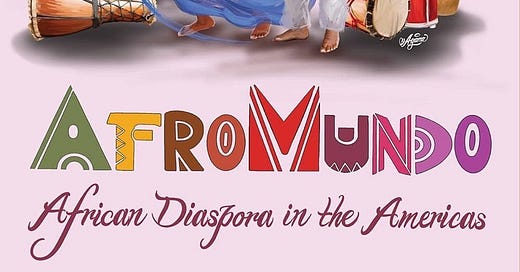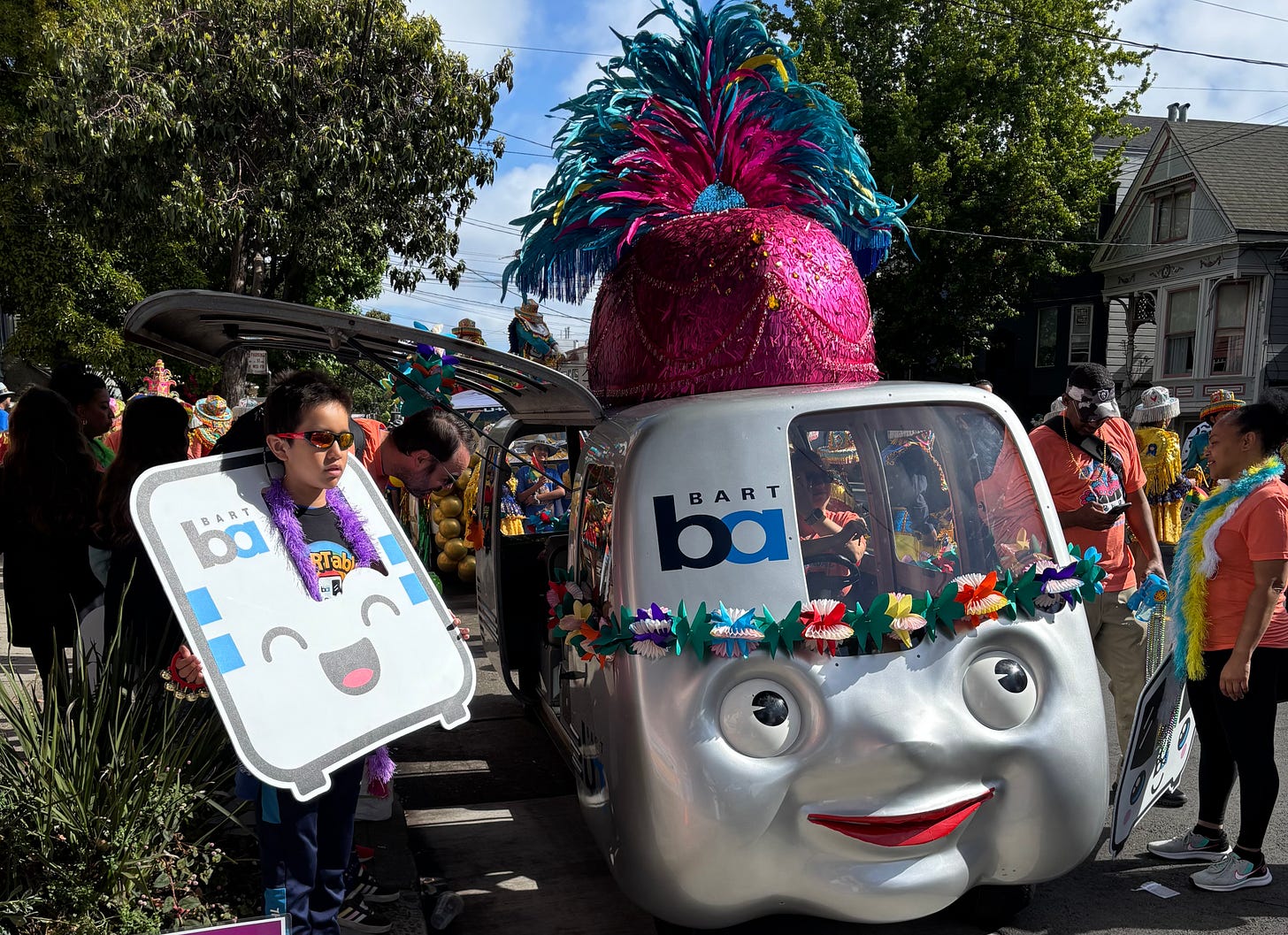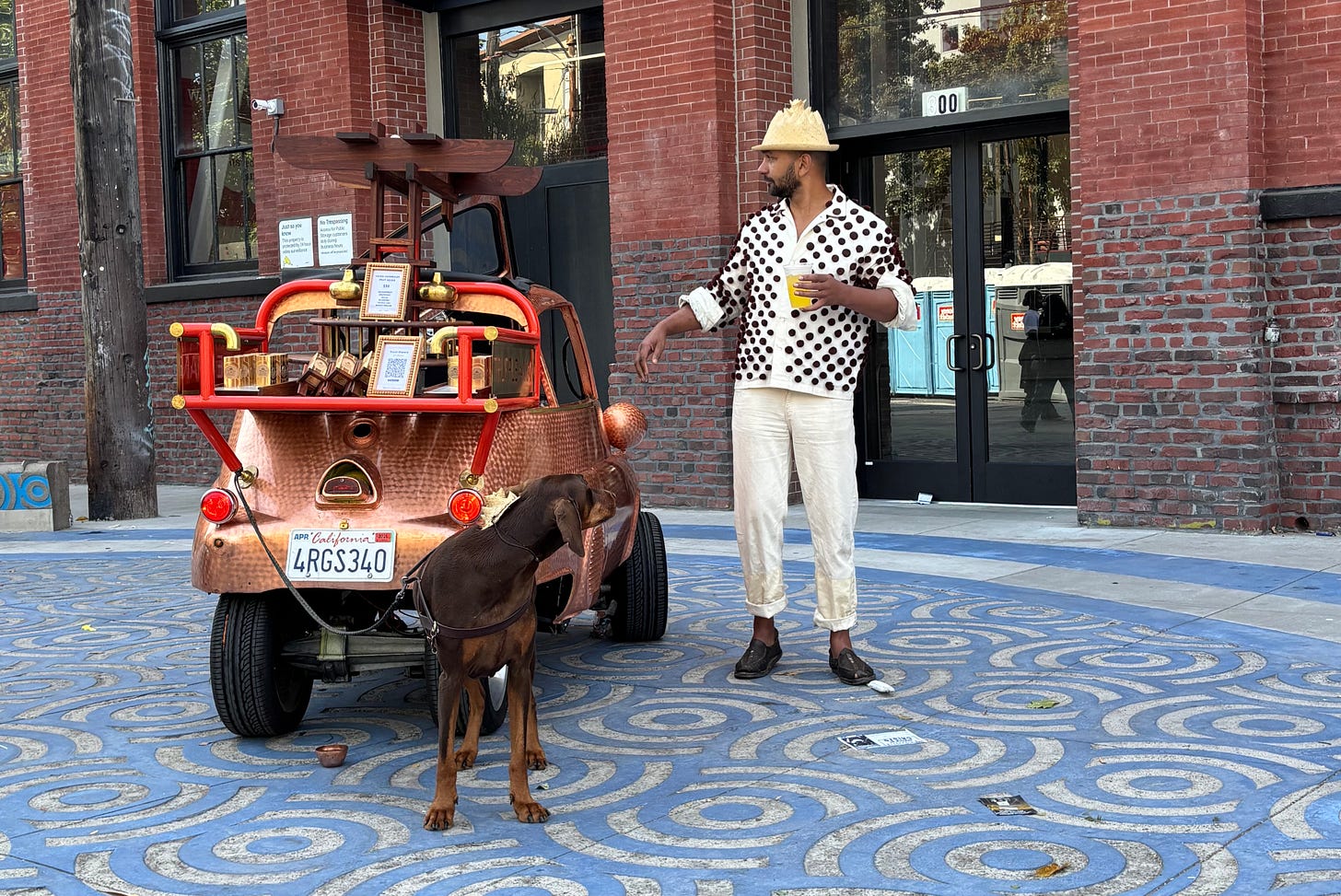A year ago, I posted about how much I love San Francisco’s annual two-day Carnaval, which reminded me that a year had passed since I wrote my first SubStack about the festival (thanks to all who have supported and stuck with me over this past year or so). This year, we needed the sense of good vibes and community more than ever as an antidote to the division and cruelty that has dominated the news. Carnaval, as always, was a celebration of immigrant cultures, as well as Native ones, and all their artistic and cultural contributions. This year’s theme was AfroMundo: African Diaspora in the Americas, celebrating the resilience, spirit, and cultural legacy of the African diaspora through music, dance, and song.
When you go to Carnaval you have to ask yourself, What would happen if Not My President had his way and deported so many of these people (even though many, of course were born right here in San Francisco)? It’s hard to imagine a San Francisco, or a US, without Carnaval’s colors, rhythms, and spirit. It would be dull, bland, and mean. Actually, the communities and cultures that Carnaval represents, aside from some musicians and artists, are just about all that keeps this town from being completely dull, bland, and mean, after two or three tech booms and busts have sucked the sangre out of its veins.
Even BART gets represented at Carnaval.
I participated with the same Cuban group I danced with last year, but wasn’t able to make 10 weeks of rehearsals, so I just did a few rehearsals playing hand percussion. More cowbell! It was generous of CultuCuba, Manuel Suarez, and the Susana Arenas Company to let me participate, because Cubans are pretty much born with great rhythm and we white girls from Denver are not. Somehow, I can dance in rhythm, but translating that to a cowbell is more difficult than you’d think. “Hay que practicar,” one of the teachers said.
Still, Carnaval was a marvelous day. It was wonderful not just because of the ability to participate in a community, and to see so many communities on display, but because it was a day of good vibes and serendipity all around.
I started the day early, riding my bike in my long white dress, makeup and beads, noticing all the vendors gathering, more and more the closer I got to the Mission. I had to stash my bike near 20th and Harrison and realized I knew three people who had places within a block, and when I forgot the code to one place, I texted my friend Ethan, who was in Amsterdam, and put it in his backyard.
I wandered to the starting point. Everyone says you have to show up at 8:30 and then you wait until the parade starts at 11, everyone fixing each other’s makeup and costumes, running through the programs, and desperately trying to find a bathroom, which becomes a theme at Carnaval. I saw some folks in costumes heading into an ADU on 23rd street and asked if I could follow them in to use the facilities, and ended up meeting a really nice crew of people who work for a non-profit; the owner of the house led me to his apartment upstairs where I pet his dog. Nice interactions.
I wandered around, taking some photos of people getting ready. I particularly loved the little kids in their costumes.

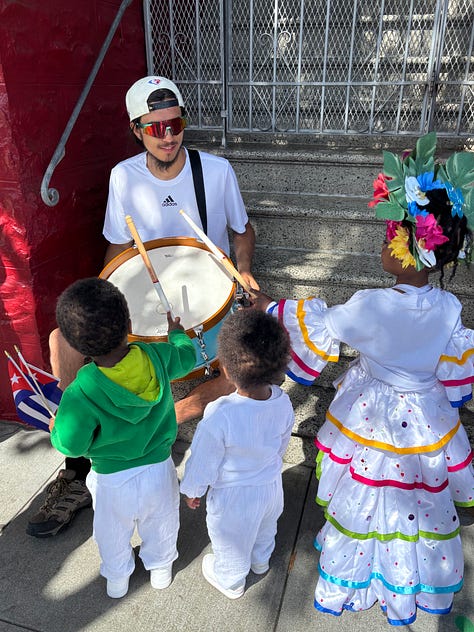
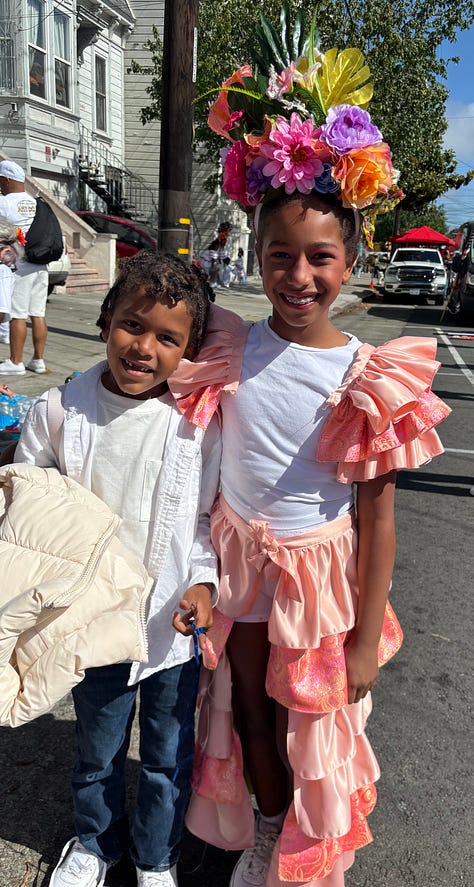
Lots of groups lined up on Bryant were revving up the low-riders, fixing their makeup, and posing for photos.
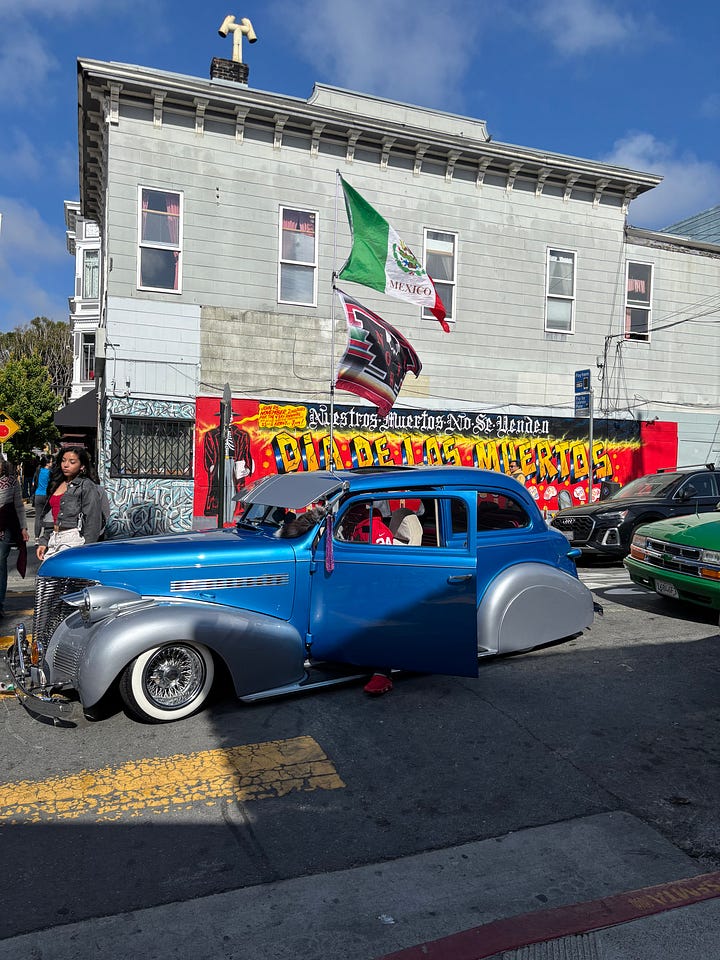
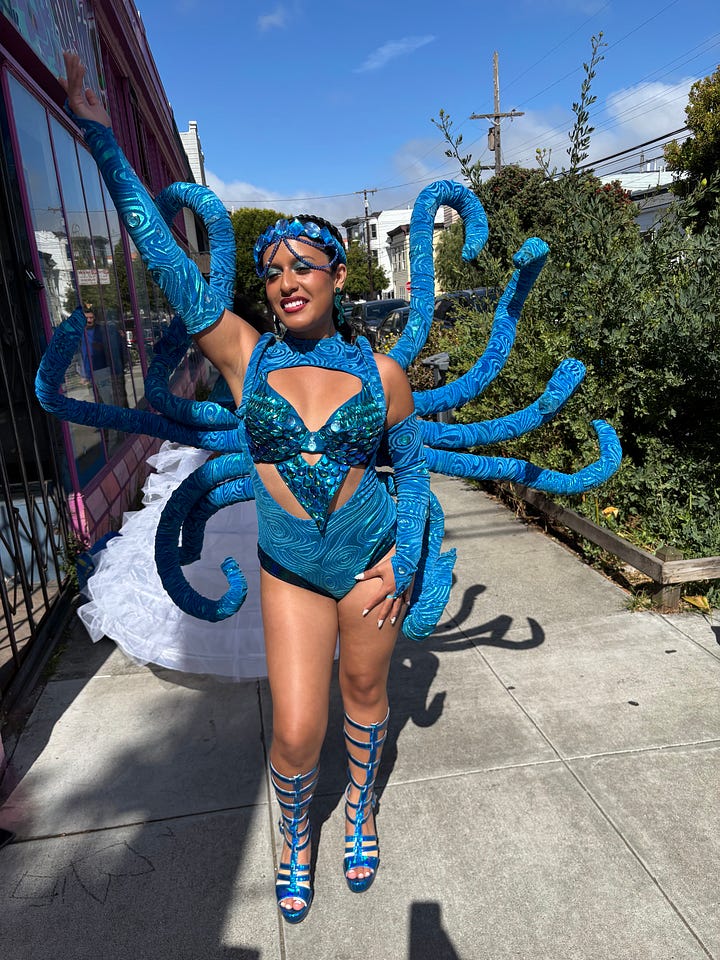

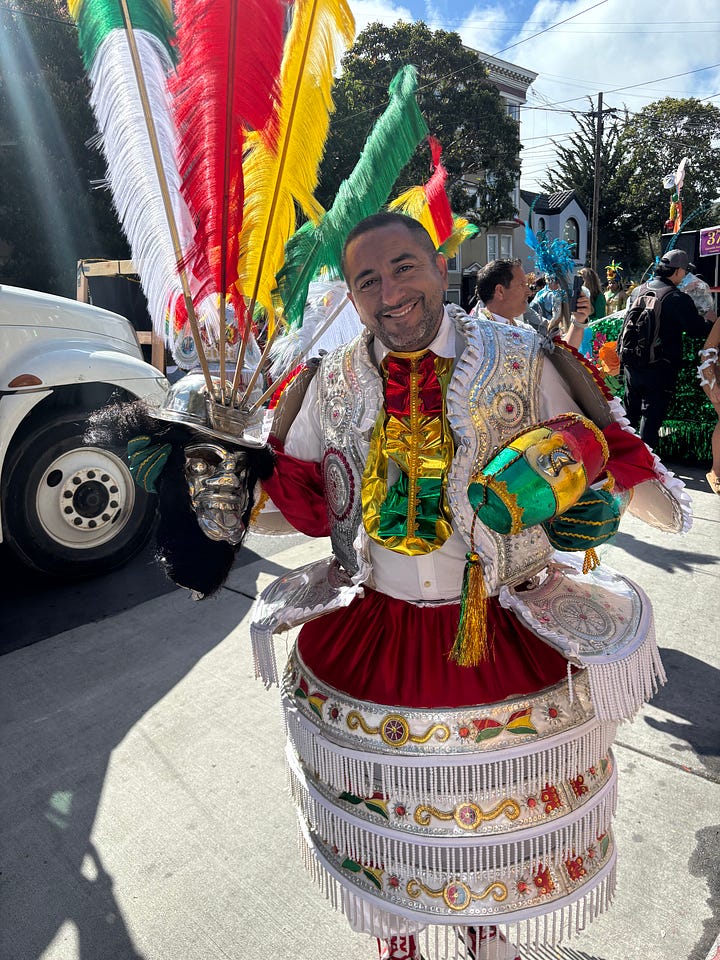
My group was as colorful as any, with Susana Arenas’ dancers honoring the Afro-Cuban orishas, divine beings who represent aspects of nature and humanity. Susana Areans, who is the queen of Cuban dance and culture in San Francisco, was dressed representingYemaya —mother of the seas, giver of life, protector of women. Other people in the dance company represented other orishas. The non-professional dance company did choreography based on both Afro-Cuban folkloric dance and styles that later were woven into salsa.
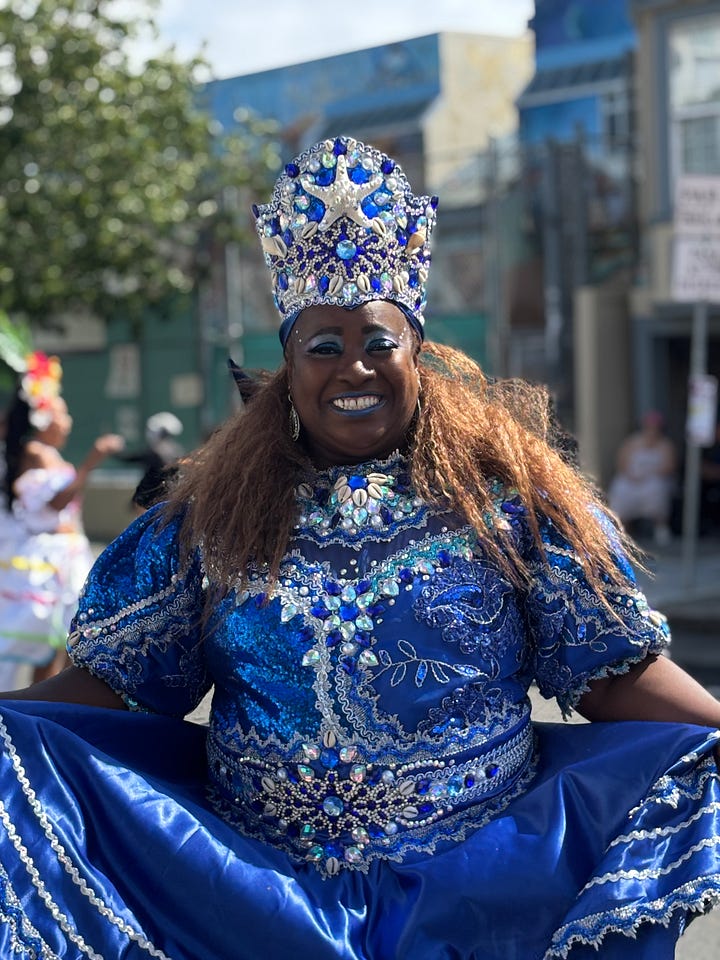
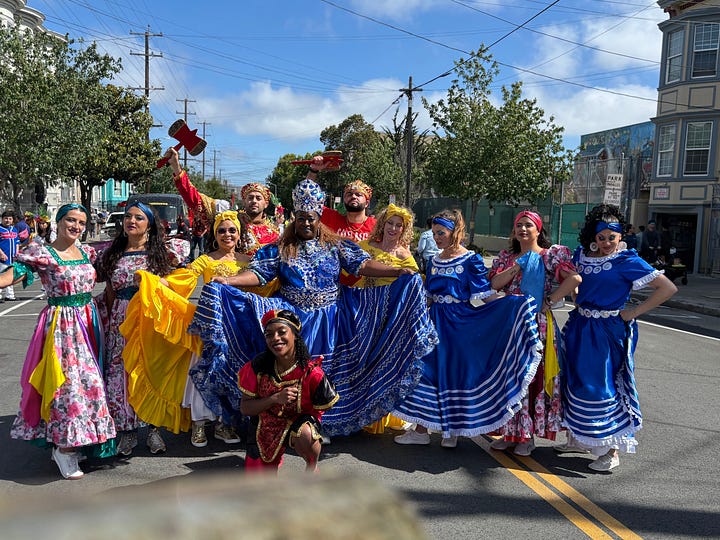
At 11:00, our group began to move, and we played congas and other percussion while the dancers did their routines. I loved being able to wave the flag of a country I’ve visited a couple of times, and admire, and feel included. The crowd loved our group. Everyone was smiling and dancing, from the streets to the sidewalks.
The end of Carnaval is always a little bit of a letdown—all those weeks of rehearsal come to a sudden stop on 15th St. I left the group to wander around the festival. I often don’t set out for a festival alone, and it was a good reminder that that’s sometimes the best way to travel. I ran into a couple friends from another dance class, Latin Dance Grooves with Elizabeth Soberanes, who had a contingent of 150, and they invited me to their party. Again, I had that feeling of being among so many people I knew over all these years of taking classes, and also had some good conversations with people I didn’t know.
I headed back out and ran into a guy, Truffle Man, with an incredible aesthetic selling gelees that contained enough magic mushroom to turn the twinkle on without seeing your own death. He drives a distinctive copper Fudge Buggy around. His dog, Kiki, was the sweetest boy with the softest ears ever. Everything, from the packaging to the taste of the gelee, was impeccable. It turns out Truffle Man used to sell his week truffles in Dolores Park, in his signature copper canisters, and then he went legit. His chocolates and gelees are kind of the definition of “artisanal.” So that was fun.
Thus fortified, I went to hear a couple of free concerts. The first was by John Santos and his group. Santos was one of the founders of Carnaval, and the dean of Bay Area percussionists who has been hugely influential in studying and spreading Afro-Cuban rhythms in this country, and has won scads of awards for his music and influence. It fun to see him playing in the streets, and not at an expensive jazz club.
In the midst of this concert, I happened to be standing near a woman who recognized me and gave me a big, warm hug. Wow, I said, we haven’t seen each other in years. We danced together and it really bothered me that I couldn’t remember her name. Then I realized she looked an awful lot like another friend of mine, but their bodies were quite different, so different that they couldn’t be the same person. I asked another woman she’d been talking to what her name was but she had no idea, either. Finally at the end of the show, she confessed that she’d forgotten my name, and I said I’d forgotten hers, too. We tried to figure out where we knew each other from, and it turns out that aside from a few dance classes, maybe, we didn’t know each other at all. “We were besties in another life,” I said.
The second show was with Edgardo Cambon, another long-time musician from the Bay Area who has led Candela, a salsa orchestra. for about 30 years. I’d heard of him because I’d taken a class from him at the Jazz School in Berkeley called “Toca and Canta,” which means play and sing, and it turned out we had to do both at the same time —in Spanish. That’s a story for another Substack, but my short time in that class made me think I could play cowbell in Carnaval, and I did, sort of. But the band was great and I had a wonderful time dancing; everyone was dancing. A man I’ve danced with around town came up and we partner danced for awhile, and then I spotted one of the percussionists who’d played in our group, and had a couple dances with him; he was a great, fluid dancer, and I dance better than I play cowbell. Just one great dance can make your day, and the day had already been full to bursting.
After the concert, I headed back toward my bike. I stopped off at my friend Saul Griffith’s cool office in an old organ factory, OtherLab, to use the facilities before retrieving my bike. My mood dropped when I saw evidence that OtherLab, an incubator of creativity, is having to lease out some of its facilities because they didn’t get the government contracts they usually get for inventions and policy about how to transition from fossil fuels to clean energy and make the electric tools to make that transition better, cooler, and more modern. It was a chilly ride back to the Haight in my white dress, and I got home completely cold, tired, hungry— but happy. And my wonderful husband Peter made pasta and salad while I had a hot shower.
At that Toca y Canta class I learned to sing a Celia Cruz song, which was appropriate for the day, and for the times:
La Vida es un Carnaval
Todo aquel que piense que la vida es desigual
Tiene que saber que no es así
Que la vida es una hermosura, hay que vivirla
Todo aquel que piense que está solo y que está mal
Tiene que saber que no es así
Que en la vida no hay nadie solo, siempre hay alguien
Ay, no hay que llorar (No hay que llorar)
Que la vida es un carnaval
Y es más bello vivir cantando
Oh-oh-oh, ay, no hay que llorar (No hay que llorar)
Que la vida es un carnaval
Y las penas se van cantando
To translate the gist, everyone who thinks that life is unequal, and that they’re alone (easy to believe in these times of Not My President) it’s not like that: life is beautiful, no one’s alone, there’s always someone. Life is a carnaval, and it’s more beautiful to live singing, your sorrows go away singing.
That’s how it is with Carnaval. In the midst of all the despicable lies and cruelty going on in our country, cuts to programs for the brightest, the least fortunate, the most deserving, there is still always community, always music and singing.


